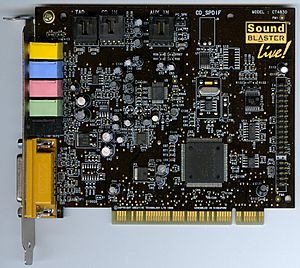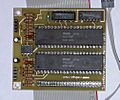Sound card facts for kids

A sound card (also called an audio card) is a special part inside your computer. It helps your computer make sounds and record sounds. Think of it as the computer's ears and mouth for audio!
Many years ago, sound cards were separate pieces you added to your computer's main board, called the motherboard. These were known as expansion cards. You could plug them in to give your computer sound abilities.
Today, most computers have sound features already built right into the motherboard. This means the sound card is part of the main board and can't be taken out easily. These built-in sound features usually have connections for speakers, headphones, and a microphone. This is enough for most people. Built-in sound cards also save space, which is great for laptops.
But if you need more advanced sound features, like connecting musical instruments using MIDI ports, or if you need very clear sound without delays (called low latency), you might still use a separate sound card. Modern separate sound cards connect using a special slot called PCI. Older sound cards used an ISA slot, which was slower and couldn't record and play sound at the same time.
Contents
How Sound Cards Work
Sound cards help your computer understand and create sound. They change digital information (like the music files on your computer) into analog signals that your speakers can play. They also change analog sounds (like your voice from a microphone) into digital information the computer can store.
From Digital to Sound
When you listen to music on your computer, here's what happens:
- The digital music file (like an MP3) is stored on your hard disk.
- A program, like a music player, sends this digital code to the sound card.
- Inside the sound card, there's a special chip called a digital-to-analog converter. This chip changes the digital code into an analog sound signal.
- This analog signal then travels to a jack (a small hole) on the sound card, usually a green one.
- Your speakers are plugged into this green jack. They receive the analog signal and turn it into the sounds you hear!
From Sound to Digital
When you speak into a microphone, the sound card does the opposite:
- Your voice creates sound waves, which the microphone picks up.
- The microphone sends these analog sound waves to the sound card, usually through a red or pink jack.
- The sound card then changes these analog sound waves into digital information.
- This digital information can be saved as a computer file. Sometimes, the file is made smaller using data compression so it doesn't take up too much space.
- All of this happens with the help of software programs on your computer.
Understanding Sound Card Colors
Sound cards have different colored connectors, or jacks, to help you know where to plug things in. These colors follow a standard guide called the PC System Design Guide. Sometimes, there are also small symbols next to the jacks to help you.
| Color | What it's for | Type | Connector | |
|---|---|---|---|---|
| Pink | Connecting an analog microphone | Input | 3.5 mm minijack | |
| Light blue | Connecting other audio devices, like a CD player or tape deck | Input | 3.5 mm minijack | |
| Lime | Connecting your main speakers or headphones | Output | 3.5 mm minijack | |
| Orange | Connecting a center speaker and a subwoofer (for deep bass sounds) | Output | 3.5 mm minijack | |
| Black | Connecting rear surround sound speakers | Output | 3.5 mm minijack | |
| Silver/Grey | Connecting side surround sound speakers (if you have them) | Output | 3.5 mm minijack | |
| Brown/Dark | Connecting speakers for special sound effects or panning | Output | 3.5 mm minijack | |
| Gold | Connecting a Game port (for old joysticks) or MIDI devices (for musical instruments) | Input | DA-15 | |
Images for kids
See also
 In Spanish: Tarjeta de sonido para niños
In Spanish: Tarjeta de sonido para niños













